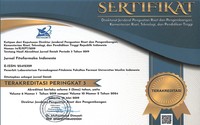Uji Aktivitas In Vivo Antinosiseptif Kombinasi Ekstrak Daun Dandang Gendis [Clinacanthus nutans (Burn F) Lindau] dan Daun Bakung (Crinum asiaticum L)
Abstract
Keywords
Full Text:
PDF (Bahasa Indonesia)References
Alam, A. et al. (2016) ‘Clinacanthus nutans: A review of the medicinal uses, pharmacology and phytochemistry’, Asian Pacific Journal of Tropical Medicine, 9(4), pp. 402–409. doi: 10.1016/J.APJTM.2016.03.011.
Asmawi, M. Z. et al. (2011) ‘In vivo Antinociceptive Activity of Leaf Extract of Crinum asiaticum and Phytochemical Analysis of the Bioactive Fractions’, International Journal of Pharmacology, 7(1), pp. 125–129. doi: 10.3923/ijp.2011.125.129.
Bribi, N. (2018) ‘Pharmacological activity of aporphinoid alkaloids. A review’, Asian Journal of Botany, 1, pp. 1–6. doi: 10.63019/ajb.v1i2.467.
Departemen Kesehatan Republik Indonesia (1995) Materia Medika Indonesia. Jilid VI. Jakarta: Departemen Kesehatan Republik Indonesia.
Dharmady, T. (2004) ‘Manajemen Nyeri dalam Suatu Tatanan Tim Medis Multidisiplin’, Majalah Kedokteran Damianus, 3(1), p. 1.
Direktorat Jenderal Pengawasan Obat dan Makanan (2000) Parameter Standar Umum Ekstrak Tumbuhan Obat. Cetakan I. Jakarta: Departemen Kesehatan RI.
Farmakope Herbal Indonesia. Edisi I (2008). Jakarta: Kementrian Kesehatan RI.
Fennell, C. W. and Staden, J. Van (2001) ‘Crinum Species in Traditional and Modern Medicine’, Journal of ethnopharmacology, 78(1), pp. 15–26. doi: 10.1016/s0378-8741(01)00305-1.
Galani, V. J. and Patel, B. G. (2011) ‘Analgesic and Anti-Inflammatory Activity of Argyreia speciosa and Sphearanthus indicus in The Experimental Animals’, Global Journal of Pharmacology, 4(3), pp. 136–141.
Guyton, A. . and Hall, J. E. (2016) Buku Ajar Fisiologi Kedokteran: diterjemahkan oleh Ermita, I dan Ibrahim Ilyas. Edisi 12. Edited by M. D. Widjajakusumah and A. Tanzil. Jakarta: Penerbit buku kedokteran EGC.
Haque, M., Jahan, S. and Rahmatullah, M. (2014) ‘Ethnomedicinal Uses of Crinum Asiaticum : A Review’, World Journal of Pharmacy and pharmaceutical sciences, 3(9), pp. 119–128.
Hayfaa, A. A.-S., Sahar, A. A. M. A.-S. and Awatif, M. A.-S. (2013) ‘Evaluation of Analgesic Activity and Toxicity of Alkaloids in Myristica fragrans Seeds in Mice’, Journal of Pain Research, 6, pp. 611–615. doi: 10.2147/JPR.S45591.
Kogure, N. et al. (2011) ‘Two New Alkaloids from Crinum asiaticum var. japonicum’, Chemical and Pharmaceutical Bulletin, 59(12), pp. 1545–1548. doi: 10.1248/cpb.59.1545.
Kosai, P., Sirisidthi, K. and Jiraungkoorskul, W. (2016) ‘Evaluation of Total Phenolic Compound and Cytotoxic Activity of Clinacanthus nutans’, Indian Journal of Pharmaceutical Sciences, 78(2), pp. 283–286. doi: 10.4172/pharmaceutical-sciences.1000115.
Kurdi, A. (2010) Tanaman Herbal Indonesia: Cara Mengolah dan Manfaatnya Bagi Kesehatan.
Marlyne, R. (2012) Uji Efek Analgesik Ekstrak Etanol 70% Bunga Mawar (Rosa chinensi Jacq.) Pada Mencit Yang Diinduksi Asam Asetat. Universitas Indonesia.
Oktaviani, M. A. and Notobroto, H. B. (2014) ‘Perbandingan Tingkat Konsistensi Normalitas Distribusi Metode Kolmogorov-Smirnov, Lilliefors, Shapiro-Wilk, dan Skewness-Kurtosis’, Jurnal Biometrika dan Kependudukan, 3(2), pp. 127–135. Available at: http://journal.unair.ac.id/download-fullpapers-biometrikd8bc041810full.pdf.
P’ng, X. W., Akowuah, G. A. and Chin, J. H. (2012) ‘Acute Oral Toxicity Study of Clinacanthus nutans in Mice’, International Journal of Pharmaceutical Sciences and Research, 3(11), pp. 4202–4204. doi: http://dx.doi.org/10.13040/IJPSR.0975-8232.3(11).4202-05.
Parmar, N. . and Prakash, S. (2006) Screening Methods in Pharmacology. 1st Editio. Oxford, U.K: Alpha Science International.
Patel, D. (2017) ‘Crinum asiaticum Linn: A Medicinal Herb as Well as Ornamental Plant in Central India’, International Journal of Environmental Sciences & Natural Resources, 6(1), pp. 1–7. doi: 10.19080/ijesnr.2017.06.555678.
Rahim, M. H. A. et al. (2016) ‘Methanolic Extract of Clinacanthus nutans Exerts Antinociceptive Activity Via The Opioid/Nitric Oxide-mediated, but cGMP-Independent, Pathways’, Hindawi: Evidence-based Complementary and Alternative Medicine, 2016, p. 11 pages. doi: 10.1155/2016/1494981.
Rahman, M. A. et al. (2013) ‘Analgesic and Anti-Inflammatory Effects of Crinum asiaticum Leaf Alcoholic Extract in Animal Models’, African Journal of Biotechnology, 12(2), pp. 212–218. doi: 10.5897/ajb12.1431.
Raya, K. B. et al. (2015) ‘Changes in Phytochemical Contents in Different Parts of Clinacanthus nutans (Burm. f.) Lindau Due to Storage Duration’, Bragantia, Cantinas, 74(4), pp. 445–452. doi: 10.1590/1678-4499.0469.
Sun, Q. et al. (2008) ‘A New Phenolic Compound from Crinum asiaticum L’, Chinese Chemical Letters, 19(4), pp. 447–449. doi: https://doi.org/10.1016/j.cclet.2008.01.02
Syarif, A. et al. (2007) Farmakologi dan Terapi. Edisi 5. Jakarta: Departemen Farmakologi dan Terapeutik FK UI.
Tiwari, P. et al. (2011) ‘Phytochemical screening and Extraction: A Review’, International Pharmaceutical Sciencia, 1(1), pp. 98–106.
Verri, W. A. et al. (2012) Flavonoids as Anti-Inflammatory and Analgesic Drugs: Mechanisms of Action and Perspectives in The Development of Pharmaceutical Forms, Studies in Natural Products Chemistry. Bioactive Natural Product. doi: 10.1016/B978-0-444-53836-9.00026-8.
Wahyuni, I. T., Astuti, N. Y. and Nuratmi, B. (2003) ‘Uji Perbandingan Efek Analgesik Infus Temu Putih (Curcuma zedoria Rosc.) dan Temu Mangga (Curcuma mangga Val. Et Zipp) pada Mencit’, Jurnal Bahan Alam, 2(3), pp. 81–84.
Zulkipli, I. N. et al. (2017) ‘Clinacanthus nutans: A Review on Ethnomedicinal Uses, Chemical Constituents and Pharmacological Properties’, Pharmaceutical Biology, 55(1), pp. 1093–1113. doi: 10.1080/13880209.2017.1288749.
DOI: https://doi.org/10.33096/jffi.v8i2.730
Copyright (c) 2021 Essty Damayanti

This work is licensed under a Creative Commons Attribution-ShareAlike 4.0 International License.
Indexed by:
ISSN: 2356-0398 | e-ISSN: 2541-2329
Editor's Address:
Third Floor Pharmacognosy-phytochemistry laboratory building, Urip Sumoharjo road km. 5 Campus II UMI, Makassar, South Sulawesi, Indonesia
Phone: +6281524045514
Fax: +62411425619
E-mail: editorjfi@umi.ac.id

















.jpg)

